For the geeks amongst us.
Apr 3, 2012 16:37:18 #
The discussion about magnification has been interesting. I understand what Nikonian72 is saying while I disagree with his definition of magnification. All of it is irrelevant when it comes to posting our work.
Here is a shot of the scale on a millimeter ruler. The image has been rotated to get the scale marks horizontal, but the image has not been cropped - only resized. The D300 image is 4288 x 2848 pixels. On my screen I measure the distance between the 2 lines marking 1mm as 45mm so the ruler is magnified 45x. That is the minimum magnification I can get using the 4x microscope objective. As I crop from there, the magnification will increase depending on the amount of crop.
If I swing the 10x objective into place, the minimum magnification will jump up to (10/4*45) or 112.4x. Unfortunately, with light loss in the system, I don't have a bright enough light to shoot the ruler with reflected light.
There is always something new to learn!
Here is a shot of the scale on a millimeter ruler. The image has been rotated to get the scale marks horizontal, but the image has not been cropped - only resized. The D300 image is 4288 x 2848 pixels. On my screen I measure the distance between the 2 lines marking 1mm as 45mm so the ruler is magnified 45x. That is the minimum magnification I can get using the 4x microscope objective. As I crop from there, the magnification will increase depending on the amount of crop.
If I swing the 10x objective into place, the minimum magnification will jump up to (10/4*45) or 112.4x. Unfortunately, with light loss in the system, I don't have a bright enough light to shoot the ruler with reflected light.
There is always something new to learn!
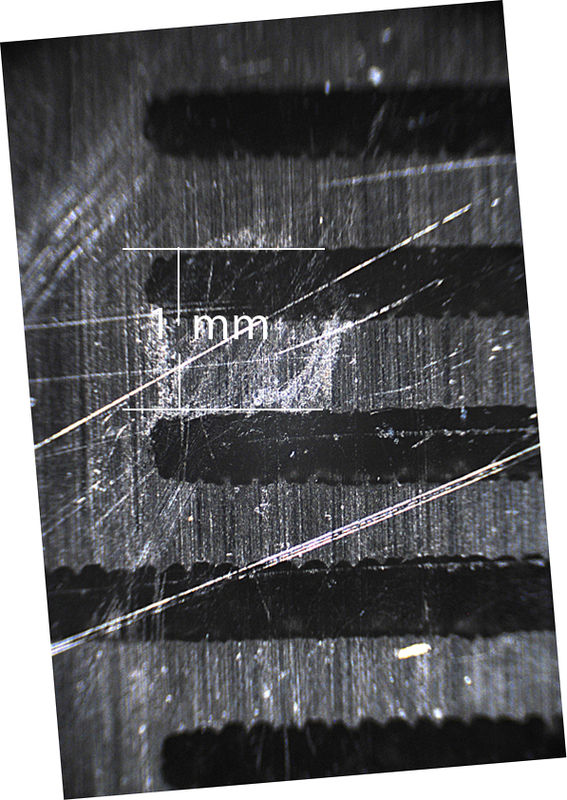
Apr 3, 2012 18:30:56 #
Apr 4, 2012 12:56:48 #
Life wouldn't be much fun if that wasn't true.
Apr 4, 2012 15:01:59 #
ngc1514 wrote:
How do you define magnification? Just curious....The discussion about magnification has been intere... (show quote)
Apr 4, 2012 16:28:54 #
For this application, it's how large an image appears on MY computer screen (it will vary for all of us according to the monitors we use and the dot pitch at which we are using them) compared to how large the object actually is. It's a pretty slippery term because it's user dependent rather than absolute like at the eyepiece of a telescope or microscope.
As I said in the opening message, I shot a millimeter ruler and viewed the image full-size on the monitor screen. Measuring the millimeter ruler at 100% in Photoshop, I found it measured 45mm on the screen or magnified 45 times.
And, now that you have me thinking about it... that number is incorrect! While I was viewing the image on Photoshop, I was looking at it at full SCREEN mode rather than actual pixel size! Viewing the image at 100%, the magnification is about 260x.
This is with the 4x objective and no microscope eyepiece. However, there is some sort of transfer lens in the camera port on the 'scope and not sure if it is a positive or negative lens.
As I mentioned in another thread, it's so much easier with a telescope. You know the focal length of the objective and the focal length of the eyepiece. Divide the fl of the objective by the focal length of the eyepiece and you get the magnification. Or, if you have an eyepiece whose focal length you don't know, you measure the size of the exit pupil and divide the diameter of the primary objective (entrance pupil) by the diameter of the exit pupil.
On the microscope, magnification is indicated on both the objective and the eyepiece. At low power, I use the 4x objective and the 10x eyepiece giving me 40x and can go up to the 100x objective and 16x eyepiece for 1600x.
The camera, at some arbitrary distance from the objective and the transfer lens make the whole thing an adventure. The only way I can figure out base magnification is through the process outlined above.
Anyone's thoughts, suggestions and advice is always welcome!
As I said in the opening message, I shot a millimeter ruler and viewed the image full-size on the monitor screen. Measuring the millimeter ruler at 100% in Photoshop, I found it measured 45mm on the screen or magnified 45 times.
And, now that you have me thinking about it... that number is incorrect! While I was viewing the image on Photoshop, I was looking at it at full SCREEN mode rather than actual pixel size! Viewing the image at 100%, the magnification is about 260x.
This is with the 4x objective and no microscope eyepiece. However, there is some sort of transfer lens in the camera port on the 'scope and not sure if it is a positive or negative lens.
As I mentioned in another thread, it's so much easier with a telescope. You know the focal length of the objective and the focal length of the eyepiece. Divide the fl of the objective by the focal length of the eyepiece and you get the magnification. Or, if you have an eyepiece whose focal length you don't know, you measure the size of the exit pupil and divide the diameter of the primary objective (entrance pupil) by the diameter of the exit pupil.
On the microscope, magnification is indicated on both the objective and the eyepiece. At low power, I use the 4x objective and the 10x eyepiece giving me 40x and can go up to the 100x objective and 16x eyepiece for 1600x.
The camera, at some arbitrary distance from the objective and the transfer lens make the whole thing an adventure. The only way I can figure out base magnification is through the process outlined above.
Anyone's thoughts, suggestions and advice is always welcome!
Apr 4, 2012 16:42:58 #
ngc1514 wrote:
I'm "old school" which defined macro as 1:1 on the film. Anything more than 10x was "micro". Not sure if I got this anywhere other than the old farts who showed me the ropes.Anyone's thoughts, suggestions and advice is always welcome!
Less than 1:1 was closeup. AND an enlargement didn't count. Technically that's what a "crop and resize" is. And I'm ok with almost no one agreeing with me- I know I'll get very little (of that) on this forum!
Apr 4, 2012 17:31:16 #
I'll go along with that, ShooterOR. As with so many categorizations, it's all pretty arbitrary.
Why is 10:1 the dividing line between macro and micro and not 9:1 or 11:1?
And at how much less than 1:1 does a close-up stop being a close-up?
Arbitrary. I kinda like "larger than life size" and "smaller than life size," but that's arbitrary as well.
NONE of which lessens the pleasure I get out of seeing some of the beautiful work the people here are doing!
And that's what counts.
Why is 10:1 the dividing line between macro and micro and not 9:1 or 11:1?
And at how much less than 1:1 does a close-up stop being a close-up?
Arbitrary. I kinda like "larger than life size" and "smaller than life size," but that's arbitrary as well.
NONE of which lessens the pleasure I get out of seeing some of the beautiful work the people here are doing!
And that's what counts.
Apr 4, 2012 17:38:17 #
ngc1514 wrote:
You nailed it. A well-composed; well-exposed image is the final arbiter....I kinda like "larger than life size" and "smaller than life size," but that's arbitrary as well.
NONE of which lessens the pleasure I get out of seeing some of the beautiful work the people here are doing!
And that's what counts.
NONE of which lessens the pleasure I get out of seeing some of the beautiful work the people here are doing!
And that's what counts.
Apr 4, 2012 17:59:56 #
ngc1514 wrote:
10:1 (10x life-size) is chosen as the beginning of "micro" because of convenience. Every jeweler owns a 10x microscope, because that is the magnification used to evaluate, and document, occlusions (flaws) in diamonds. For better than a century, 10x was the standard of the diamond industry, and became a standard for any magnification requiring more than a simple lens.Why is 10:1 the dividing line between macro and micro and not 9:1 or 11:1?
And at how much less than 1:1 does a close-up stop being a close-up?
And at how much less than 1:1 does a close-up stop being a close-up?
1:1 (life-size) is easily measurable. It isn't "almost", or "nearly" or "close to", it is exact. With film, all a photographer needed to do was to lay the subject directly on a negative or positive film to show exact size match. With digital, photographing a metric ruler, then comparing sensor image to known size of sensor is a very easy way of documenting any digital magnification.
105-mm MWD field of view on a 24-mm wide APS-C sensor = 1:1 (life-size)
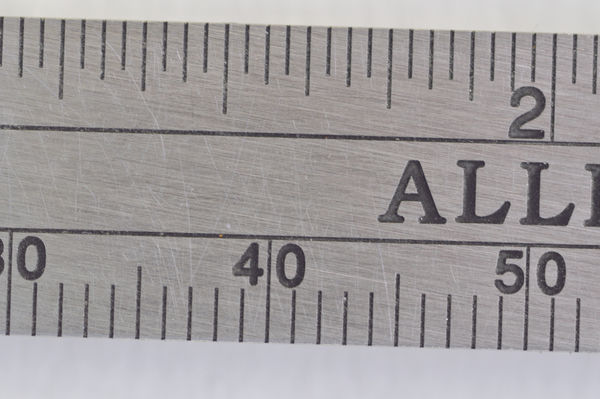
105-mm with 68-mm tubes at MWD field of view on a 24-mm wide APS-C sensor = 4:1 (4x life-size)
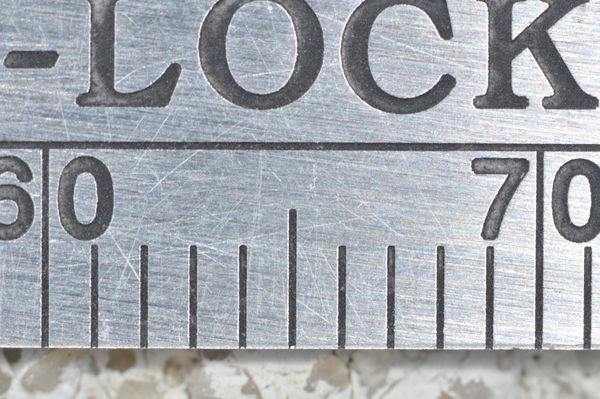
Apr 4, 2012 18:12:13 #
Nikonian72 wrote:
Thanks. The memory ain't what it used to be. I had heard the "micro/10x" explanation before--just didn't remember when I had to! quote=ngc1514 Why is 10:1 the dividing line betwe... (show quote)
<Now where did I put that screwdriver?>
No not the drink-- I can always find that!
Apr 20, 2012 19:11:31 #
Ordered a stage micrometer from the web in order to get a handle on actual magnification (and no, Douglass, we will just have to use our own definition!). The micrometer is a tiny dot on a microscope slide that is a 2 mm scale divided into 1/10mm divisions and one such division divided into 1/100mm. For those who use the metric scale, 1/10mm is 100 microns and the 1/100mm is 10 microns.
These are 100% crops. The first taken with the 4x objective and the second with the 10x.
These are 100% crops. The first taken with the 4x objective and the second with the 10x.
4x objective
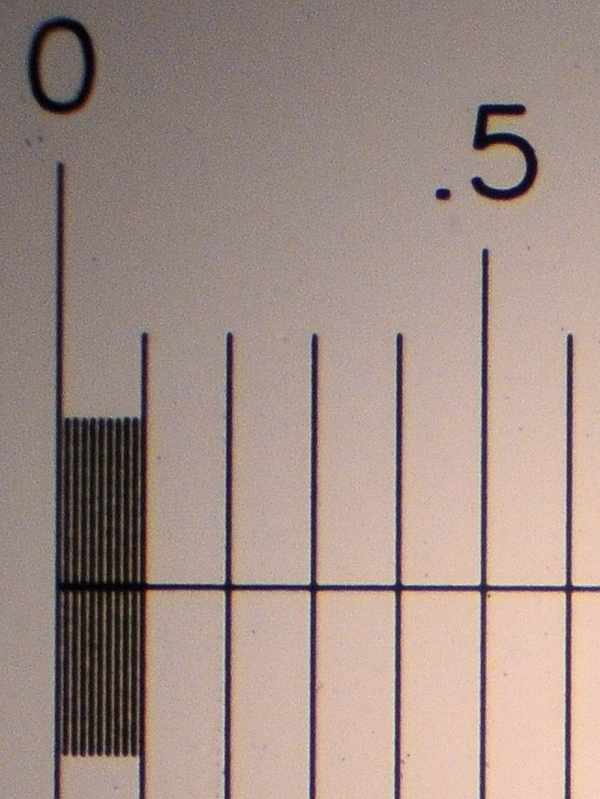
10x objective
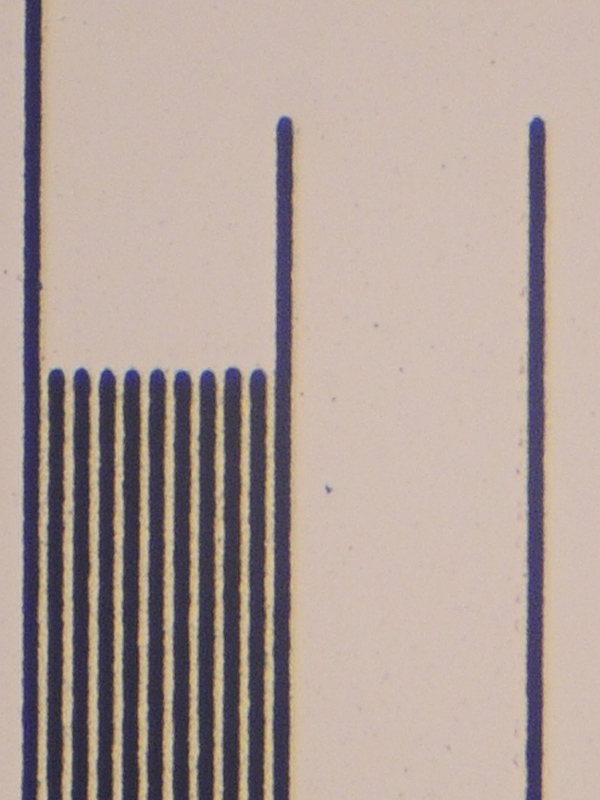
Apr 20, 2012 20:41:48 #
So, the first image is about 700-microns across, and the second image is not quite 250-microns across?
Apr 20, 2012 21:27:10 #
Sounds about right, Douglass. To give a sense of scale, most bacteria are between .5 and 5 microns in size. Whole new worlds to explore!
Apr 25, 2012 20:14:48 #
Adding one more microscope shot. This one was taken with the 40x objective. As you can see the 100% crop from the original image is about 45-50 microns in width.
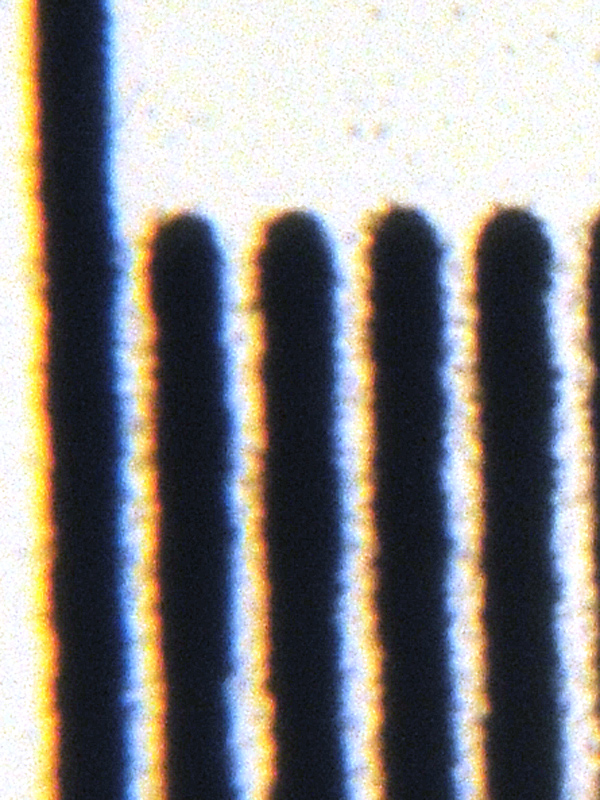
Apr 25, 2012 20:23:24 #
And for anyone interested - these are the full-sized images straight from the camera.
Taken with the 4x objective
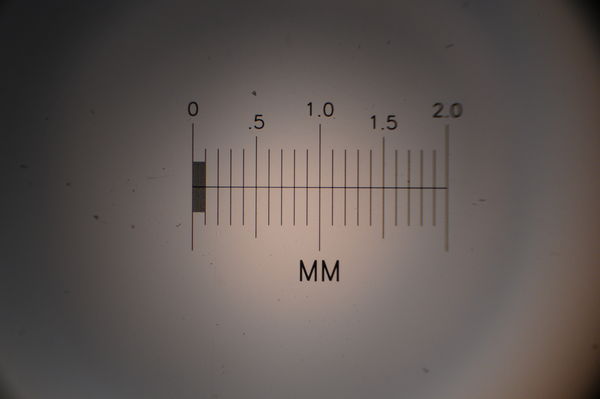
Taken with the 10x objective
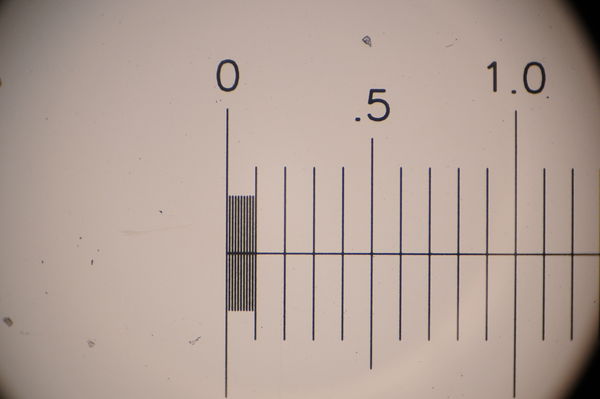
Taken with the 40x objective
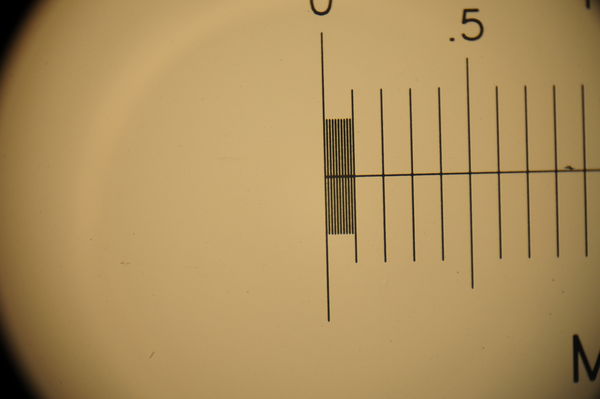
If you want to reply, then register here. Registration is free and your account is created instantly, so you can post right away.

